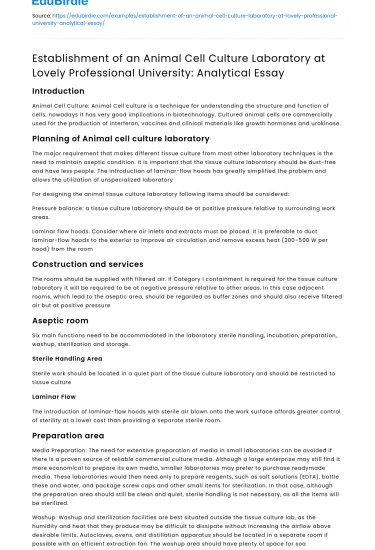Introduction
The establishment of an animal cell culture lab at Lovely Professional University (LPU) is a significant step toward enhancing the institution's research capabilities and academic offerings. Animal cell culture technology, which involves the growth of animal cells under controlled conditions outside their natural environment, is pivotal for various biological research and industrial applications. It provides a platform for studying cellular responses, drug development, cancer research, and genetic engineering, among others (Freshney, 2010). In recent years, the demand for skilled professionals in cell culture techniques has surged, driven by advancements in biotechnology and pharmaceuticals. Therefore, setting up a dedicated lab at LPU will not only bolster the university's research infrastructure but also prepare students for emerging careers in the life sciences. This essay explores the rationale, benefits, and potential challenges associated with the establishment of an animal cell culture lab at LPU.
Rationale for the Establishment of the Lab
The primary rationale behind establishing an animal cell culture lab at LPU is to enhance the educational and research framework within the life sciences department. A dedicated lab would provide students and researchers with access to state-of-the-art facilities and resources necessary for conducting advanced experiments. As per the insights shared by Gstraunthaler (2003), the availability of cell culture facilities is crucial for fostering an environment of innovation and experimentation, thereby facilitating critical breakthroughs in scientific research.
Save your time!
We can take care of your essay
- Proper editing and formatting
- Free revision, title page, and bibliography
- Flexible prices and money-back guarantee
Moreover, the introduction of such a lab aligns with LPU's strategic objective of becoming a leader in scientific education and innovation. By integrating cell culture techniques into the curriculum, the university can offer specialized courses and training programs that cater to the growing demand for expertise in biotechnology. This initiative is also expected to encourage interdisciplinary collaborations, drawing on fields such as bioinformatics, molecular biology, and pharmacology. As a result, LPU can position itself as a hub of excellence in life sciences education, attracting both national and international students.
Furthermore, the establishment of an animal cell culture lab can significantly boost LPU's research output. It will enable faculty and students to undertake cutting-edge research projects that address pressing global health challenges, such as cancer and infectious diseases. By contributing to the global scientific community, LPU can enhance its academic reputation and expand its network of research partnerships with leading institutions worldwide.
Benefits of an Animal Cell Culture Lab
There are numerous benefits associated with the establishment of an animal cell culture lab at LPU. Firstly, it provides a controlled environment for conducting experiments that require precision and accuracy. This is particularly important in fields like toxicology and pharmacology, where understanding cell responses to various compounds is crucial (Masters, 2000). With access to a fully equipped lab, students can gain hands-on experience in designing and executing experiments, thereby enhancing their practical skills and employability.
Additionally, a cell culture lab supports the development of new therapeutic approaches and medical treatments. For instance, researchers can use cell culture techniques to test the efficacy and safety of new drugs before proceeding to clinical trials. This reduces the reliance on animal testing, aligning with ethical standards and promoting the principles of the 3Rs (Replacement, Reduction, and Refinement) in scientific research (Russell & Burch, 1959). In this context, LPU's lab could contribute to reducing the environmental and ethical impact of scientific research.
Moreover, the lab can serve as a platform for industry collaboration and technology transfer. By partnering with pharmaceutical and biotechnology companies, LPU can facilitate the development of innovative products and solutions. Such collaborations can lead to patentable discoveries and commercial ventures, providing economic benefits to the university and enhancing its contribution to the regional economy.
Challenges and Counter-Arguments
Despite the numerous advantages, the establishment of an animal cell culture lab at LPU may face certain challenges. One of the primary concerns is the significant financial investment required for setting up and maintaining the lab. This includes costs associated with purchasing equipment, hiring skilled personnel, and ensuring compliance with regulatory standards. However, these financial constraints can be mitigated through strategic partnerships with industry stakeholders and government funding agencies. According to the National Institutes of Health (NIH), collaborative research grants and public-private partnerships can provide the necessary financial support for such initiatives (NIH, 2019).
Another counter-argument is the potential risk of contamination and biohazard exposure associated with cell culture experiments. To address this, stringent safety protocols and training programs must be implemented to ensure that lab personnel are adequately equipped to handle such risks. This involves regular audits, adherence to biosafety guidelines, and the establishment of a robust quality control system (Biosafety in Microbiological and Biomedical Laboratories, 2009).
Lastly, some skeptics may argue that virtual simulations and in silico models can replace traditional cell culture techniques. While these technologies offer valuable insights, they cannot fully replicate the complexities of live cell interactions. Therefore, the physical presence of a cell culture lab is indispensable for comprehensive biological research and education.
Conclusion
In conclusion, the establishment of an animal cell culture lab at Lovely Professional University represents a strategic investment in the future of scientific research and education. It offers numerous benefits, including enhanced research capabilities, improved educational outcomes, and increased industry collaboration. While there are challenges associated with financial investment and safety concerns, these can be addressed through strategic planning and collaboration with industry and government partners. By overcoming these obstacles, LPU can position itself as a leader in life sciences education, contributing to global scientific advancements and addressing critical health challenges. As such, the establishment of a cell culture lab is not only a step forward for LPU but also a significant contribution to the broader scientific community.






 Stuck on your essay?
Stuck on your essay?

